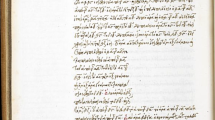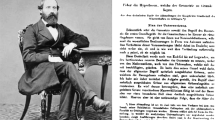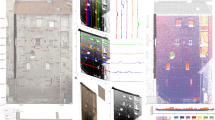Abstract
This paper focusses on the relationship between representation, computation and drawing measurability of geometrical shapes: a question that both architects and mathematicians address during their work and research. The case-study of the regular polyhedra is examined, acting as a support for a broader reflexion on the many aspects of scientific representation.
Similar content being viewed by others
Avoid common mistakes on your manuscript.
Introduction
This research inquires into the relationship between mathematics and figurative representation, and more precisely between drawing and computation. Architectural shapes need to be quantified before being built. The designers assign some dimensions – lengths, heights, radii – to the shapes they imagine, and consequently other quantities such as areas, volumes, perimeters are defined. When the shapes are digitally modelled those numbers can be easily calculated by today’s modern working tools: the computers.
Indeed, ever since classical antiquity, in which the permitted drawing tools were ruler and compass only, graphic representation has acted as a computation tool. Greek mathematicians were able to compute rational and irrational magnitudes by drawing lines and curves on tablets or parchments.
This paper focusses on the relationship between the representation of the five regular polyhedra and their computation, discussing various representation techniques and their efficacy to calculate sizes and proportional ratios.
The Research
Ever since Plato’s day, together with other mathematical objects or concepts, the five regular polyhedra have been considered to be beautiful. They are equiangular and equilateral. A single parameter ‒ i.e., the length of their edge ‒is enough to determine their size and proportions. Books 11, 12 and 13 of Euclid’s Elements are dedicated to solid geometry and Book 13 focuses on the regular polyhedra. The goal is to determine the proportion of the edges of the five solids with respect to the diameter of the sphere in which they are all inscribed.
From the earliest preserved manuscripts, dated from the 9th century A.D. to the end of the 15th century, the first four polyhedra (tetrahedron, cube, octahedron and icosahedron) are always represented by a couple of images: a planar diagram where the sphere is represented by a closed semi-circle, in which a length is inscribed, and a 3D projection of the solid itself which illustrates the procedure of its construction and subsequent analysis, following the explanation of the accompanying text. The measurable image is the first one: it shows two incommensurable lengths drawn in the same scale. This second image is the descriptive one, even though not always visual. The descriptive image is the one which varies from manuscript to manuscript, while the semi-circle of the first diagram never changes and never disappears.
The fifth polyhedron – the dodecahedron – is defined through its relationship to the cube that it contains: therefore no reference is done to the circumscribing sphere and its diameter. A single geometric construction illustrates the explanatory text and the relation between cube and dodecahedron (Fig. 1).
The Production of Images for the Elements
A quick overview of several manuscripts from different countries and periods immediately shows that all manuscripts contain some erroneous images [Murdoch 1971, 1984]. The errors are not always the same and do not always affect the same illustrations, but no manuscript is without errors. The image copyists – who were not the same as the text copyists – were obviously not aware of the issues that were at stake and were given imprecise instructions from their commissioners who, in turn, probably felt free to “adapt” or “improve” earlier images, even when without expertise in this field.
It seems evident that the ancient Greeks had not yet established a scientific geometric system of representation for 3D objects. The most recurrent drawing technique for solid geometry (cylinders, prisms, polyhedra, etc.) in Euclid’s Elements, is close to what is known today as the oblique axonometry. Seen in oblique axonometry, the solids have one face seen in true shape and size, which would be measurable, and all parallelisms are preserved.
We have written evidence that the study of the polyhedra relied mainly on the building and manipulation of 3D models:
… The very things which they mould and draw, which have shadows and images of themselves in water … but what they really seek is to get sight of those realities which can be seen only by the mind (Plato, Republic, book VI, 510e).
Indeed, the shadows cast on a plane may have subtended some of the representations of the solids, especially the tetrahedron, the octahedron and the cube. Shadows, too, belong to the category of axonometric projections (Fig. 2).
The Turning Point
Luca Pacioli’s De Divina Proportione (1509), containing 60 drawings of regular and stellate polyhedra by Leonardo da Vinci, is a milestone in the history of mathematical illustration [Ciocci 2020]. The quality, size, and artistic rendering of the original coloured images go beyond the requirements of mathematical demonstration. Indeed, Leonardo was the very first to produce visual representations of the solids in such a recognizable form. For the first time Leonardo’s drawings make the subject of the research understandable to non-scholars, making communication, education and dissemination easier. However Leonardo’s are not scientific perspectives patiently constructed following Piero della Francesca’s instructions contained in the manuscript De Prospectiva Pingendi (1482 ca.). They are “portraits” of models hanging in front of him. The comparisons between Leonardo’s drawings and perspective views constructed “dot by dot” show discrepancies that the various reproduction steps of the image (photographing, scanning, printing) are not enough to justify. Nonetheless the views are accurate enough for the shape to look familiar, beautiful and fully understandable (Fig. 3).
Modernization
Thanks also to the invention of mechanical printing, the second half of the sixteenth century is marked by a desire to make Euclid’s Elements accessible to a broader audience. The Latin text is translated into the vulgar (Italian, English, French, etc.) and editors tend to revise the traditional figures – not always successfully – for the greater ease of the readers. In 1570, Sir Henry Billingsley, in the very first English edition of the Elements, goes as far as inserting pop-ups in the book, which can be unfolded by the reader to form simple 3D paper models.
The mathematician Federico Commandino (1509 -1575) is the first Italian editor of Euclid to introduce perspective views into the treatise [Sorci 2006]. Commandino edited two versions of the Elements: a first one in Latin (1572) and a second one in Italian (1575). The first noticeable fact is that in both editions the images are very accurate, and no mistakes are to be found anywhere. He personally revised and corrected the whole corpus of illustrations of the treatise, controlling the printing process.
The innovative perspective views are either added to the traditional images, substitute some of them, or transform previous ones (Fig. 4).
The graphic aspect of the drawings is unchanged. They still appear as wireframe diagrams: all lines have the same weight; no value or color is applied to differentiate between lines that are in the back or in the front of the transparent solid.
Following Commandino, later Renaissance publications make use of perspective views, such as the reedition of the Arabic version by Al-Tusi (1201 – 1274) printed by the Typografia Medicea in 1594. However this innovation cannot be considered an immediate success, and was not systematically adopted, especially outside Italy (Fig. 5).
The Visible and the Intelligible
Beside writing the Elements, Euclid also produced a short treatise entitled Optics, in which he inquires into the many discrepancies between our natural vision and reality, namely, that equal objects do not appear to be of the same dimension when they are far from or close to the eye of the observer. Optics is surely not a book about perspective, but it confirms in scientific terms what Plato had already asserted in his philosophical debates: the difference between the visible and the intelligible. In our case: the visible, the intelligible and the measurable.
No perspective image ever appears in the ancient manuscripts of the Elements, and this cannot be a coincidence.
Conclusion and Open Questions
The Renaissance is a time in which progress is made simultaneously in the sciences and in the arts, sometimes promoted by the same polymaths.
What do scholars expect from mathematical illustrations? Must they be conceptual, diagrammatic, expressive, descriptive, self-explanatory, measurable, visual, artistic, or other?
The trilogy of images adopted by Commandino for the study of both the tetrahedron and the octahedron is the most interesting evolution from classicism. The measurable-descriptive diptych transforms into a measurable-descriptive-visual triptych. It does not alter the Euclidean approach to solid geometry but makes good use of the modern progress in art and representation, for the sake of didactics. If not widely adopted, Commandino’s innovations anyway influenced later contemporary editions. In the Elements edited by the historian of mathematics Sir Thomas Heath in 1908, some images come from Commandino. Heath’s choice is to modernize both the text, in which he includes algebraic equations to support the ancient Greek demonstrations, and the corpus of images which mixes original irreplaceable drawings with new axonometric and perspective views in which lines are distinguished according to their “visibility”. Emphasis is put on the visible, for the sake of the intelligible (Fig. 6).
References
Ciocci, Argante. 2020. Luca Pacioli, Leonardo da Vinci e il disegno dei poliedri. In Arte e Matematica in Luca Pacioli e Leonardo da Vinci, ed. Matteo Martelli, 43–86. Città di Castello (PG): Nuova Prhomos.
Murdoch, John E. 1971. Euclid: transmission of the Elements. In Dictionary of Scientific Biographies, 4: 437-459. New York: Scribner’s sons.
Murdoch, John E. 1984. Album of Science - Antiquity and the Middle Ages. New York: Scribner’s Sons.
Sorci, Alessandra. 2006. I corredi iconografici degli Elementi di Euclide dai codici alle edizioni a stampa del 15. e 16. secolo. Florence: self-published Ph.D. thesis.
Author information
Authors and Affiliations
Corresponding author
Ethics declarations
Conflict of Interest
The author states that there is no conflict of interest.
Additional information
Publisher’s Note
Springer Nature remains neutral with regard to jurisdictional claims in published maps and institutional affiliations.
About this article
Cite this article
Duvernoy, S. Polyhedra Representation in Editions of Euclid’s Elements. Nexus Netw J 25 (Suppl 1), 139–145 (2023). https://doi.org/10.1007/s00004-023-00693-5
Accepted:
Published:
Issue Date:
DOI: https://doi.org/10.1007/s00004-023-00693-5










